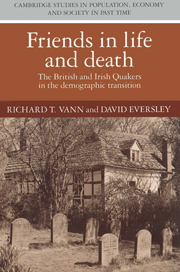Book contents
- Frontmatter
- Contents
- List of figures
- List of tables
- Preface
- Introduction
- 1 The quality of the sources
- 2 Characteristics of the sample
- 3 Marriage according to Truth
- 4 The fruitfulness of the faithful
- 5 The quality and quantity of life
- Conclusion
- Bibliography
- Index
- Cambridge Studies in Population, Economy and Society in Past Time
2 - Characteristics of the sample
Published online by Cambridge University Press: 23 September 2009
- Frontmatter
- Contents
- List of figures
- List of tables
- Preface
- Introduction
- 1 The quality of the sources
- 2 Characteristics of the sample
- 3 Marriage according to Truth
- 4 The fruitfulness of the faithful
- 5 The quality and quantity of life
- Conclusion
- Bibliography
- Index
- Cambridge Studies in Population, Economy and Society in Past Time
Summary
This chapter deals with two questions: how representative of the British and Irish Quakers as a whole our sample was, and how representative of the population as a whole the British and Irish Quakers were.
The three main sources which we used, digested registers, family lists (in Ireland), and genealogies, need to be discussed in turn in order to answer the first question. Both of us contributed something to the work on the registers, starting independently and adopting somewhat different procedures (though eventually harmonizing our methods). David Eversley included all usable Irish and Scottish families, but for the English registers adopted a sampling procedure. Families where the surname of the bridegroom or father began with the letter “B” – usually from 10 to 15 percent of the whole – were reconstituted by volunteers from the following Quarterly Meeting registers: London & Middlesex, Westmorland, and Yorkshire. For several smaller meetings, a larger sample was obtained by including families whose surnames began with either “B” or “S“: these were Cheshire, Sussex & Surrey, and Hereford, Worcester & Wales. Sampling of this sort was not used by Richard Vann, who supervised the compilation of family reconstitution forms for every family formed between 1655 and 1840 for which a birth or marriage was recorded in the registers for the following Monthly and Quarterly Meetings: Bedfordshire & Hertfordshire, Berkshire & Oxfordshire, Bristol, Buckinghamshire, Cambridgeshire & Huntingdonshire, and Norfolk (with Norwich treated separately).
- Type
- Chapter
- Information
- Friends in Life and DeathBritish and Irish Quakers in the Demographic Transition, pp. 32 - 79Publisher: Cambridge University PressPrint publication year: 1992

